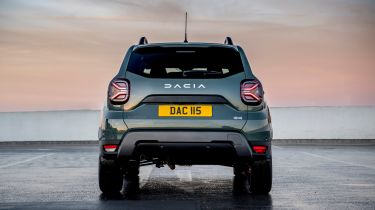Dacia Duster review - MPG, running costs & CO2 (2018-2024)
Neither the Dacia Duster's purchase price nor its running costs are likely to break the bank
The Dacia Duster is based on tried-and-trusted Renault mechanical parts. As a model that's designed to deliver value above all else, it doesn't exactly break any technological barriers, which means it goes without some of the French company's latest and most economical engines.
Although its fuel-economy figures don't shine, a low initial purchase price, surprisingly low depreciation and reasonable maintenance and insurance costs mean the Duster should prove relatively affordable in daily use. Given that all models need a lower upfront deposit than many rivals, you could get a new car and enjoy a few holidays with the money you’ve saved as well.
Dacia Duster MPG & CO2
No version of the Dacia Duster comes close to offering headline-grabbing fuel-economy figures. The Renault Captur – from Dacia's sister company – uses more sophisticated petrol and hybrid engines and delivers more impressive fuel economy as a result. However, if you don't plan to cover a huge annual mileage, the Duster's higher fuel consumption is unlikely to break the bank.
The Duster engine range starts with the TCe 90, which despite its small 1.0-litre engine, has more torque than the 1.6-litre petrol it replaced. It also has a respectable claimed fuel economy figure of up to 45.6mpg and a CO2 emissions figure of 140g/km.
More reviews
Buyers can also pick a TCe 100 Bi-Fuel model, which is the same price as the TCe in Expression trim. It makes use of the same 1.0-litre petrol but adds a 50-litre LPG tank to the standard petrol set-up. The engine emits 9.5% less CO2 while using LPG, and the two fuel sources give a 767-mile range. It’s capable of up to 44.1mpg and emits 145g/km when running on petrol, with 35.8mpg and 127g/km possible when running on LPG gas.
The major benefit is that LPG – available at around 1,400 filling stations – is around 40% cheaper than petrol, allowing high-mileage drivers to save money. It's also worth noting that as with LPG conversions, the Duster Bi-Fuel can't be taken on the Channel Tunnel, but Dacia says it is safe to be used in underground car parks.
We'd recommend going for the 1.3-litre petrol engine if you can afford it, as it's punchier and more powerful, yet has the same official fuel economy figure as the entry-level TCe 90 and more frugal than the TCe 100 Bi-Fuel when running on petrol. In TCe 130 form with a six-speed manual gearbox and 128bhp, this engine returns up to 45.6mpg and CO2 emissions of 141g/km. Opt for the 148bhp version and the automatic gearbox is standard, meaning economy only slightly drops to 44.8mpg, with emissions of 142g/km.
VED (road tax) costs the standard annual rate, although the first year's tax is likely to be included in the price. The Bi-Fuel version qualifies as an alternative fuel vehicle, so costs the discounted rate.
Insurance
The Association of British Insurers (ABI) has announced that insurance-group ratings for the latest Dacia Duster range from groups nine to 11 for the petrol engine and groups 13 to 14 for the diesel, depending on trim level. This means the latest Duster undercuts rivals such as the Nissan Qashqai – which occupies insurance group 13 and above – on insurance costs, but our advice is that you always seek a quote before you make a purchase decision.
Servicing
Every Dacia requires annual servicing, or more frequently if you cover more than 12,000 miles a year. Dacia service centres usually share workshops with Renault and both brands use similarly qualified technicians, so Dacia service expertise isn't hard to come by. Costs should be reasonable, too, and a maintenance package is available that makes it easy to budget for scheduled work.
Owing to the Duster's SUV nature, tyres are among the priciest consumable items you'll need to factor for, but even the price of these is made reasonable by 17-inch wheels being the biggest offered in the Duster range. Brakes and many other mechanical parts are shared with Renault models.











